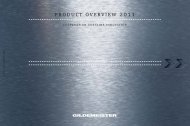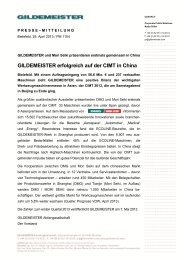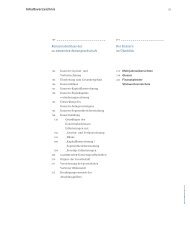PDF (7.3 MB) - GILDEMEISTER Interim Report 3rd Quarter 2012
PDF (7.3 MB) - GILDEMEISTER Interim Report 3rd Quarter 2012
PDF (7.3 MB) - GILDEMEISTER Interim Report 3rd Quarter 2012
- No tags were found...
Create successful ePaper yourself
Turn your PDF publications into a flip-book with our unique Google optimized e-Paper software.
152Consolidated Financial Statements of gildemeister Aktiengesellschaft: Notes to the Consolidated Financial StatementsThe “loans and receivables” category at the gildemeister group contains trade receivables,other original financial assets, and cash and cash equivalents. In principle, assetsin this category are measured applying the effective interest method. Non-interest bearingloans and non-interest bearing receivables are discounted unaccrued interest on theircash value.Assets “held for trading” are measured at fair value. This includes, in addition tosecurities in current assets for which there is an active market, derivative financial instruments,which are not included in an effective hedging arrangement according to ias 39(Financial instruments: Recognition and Measurement) and thus have to be compulsorilyclassified as “held for trading”. Any profit or loss resulting from subsequent measurementis recognised in the income statement.Conversion of financial instruments to other measurement categories did not occureither in the financial year 2010 or in the previous year.Financial liabilities are measured at fair value on initial recognition. For all financialassets not subsequently measured at fair value, the transaction costs directly attributableto the acquisition are also assessed and amortised over the term. Within the scope ofsubsequent measurement, ias 39 differentiates between the category “financial liabilitiesat amortised cost” and the category “held for trading”.consolidated financialstatementsDerivative financial instrumentsThe hedging of risk items from currency and interest rate fluctuations is carriedout through the use of derivative financial instruments such as foreign exchange futurecontracts and interest rate swaps. The hedging covers financial risks from underlyingtransactions entered in the books, for interest rate swaps risks out of future interest ratechanges and, in the case of currency risks, also risks from pending supply and servicetransactions.Pursuant to ias 39 “Financial Instruments: Recognition and Measurement”, allderivative financial instruments are recognised at fair value at their initial measurement.Fair value is also relevant for subsequent measurements. Fair value of traded derivativefinancial instruments corresponds to market value. This value may be positive or negative.If no market values are available, the fair value must be calculated using an acceptedeconomic method. The fair value of derivatives corresponds to the cash value of estimatedfuture cash flows. The fair value of foreign exchange future contracts is calculated on thebasis of the foreign exchange reference rate applicable at the end of the reporting period,taking into account the forward discounts and mark-ups for the respective residual termof the contract compared to the contracted forward exchange rate. Interest swaps are















